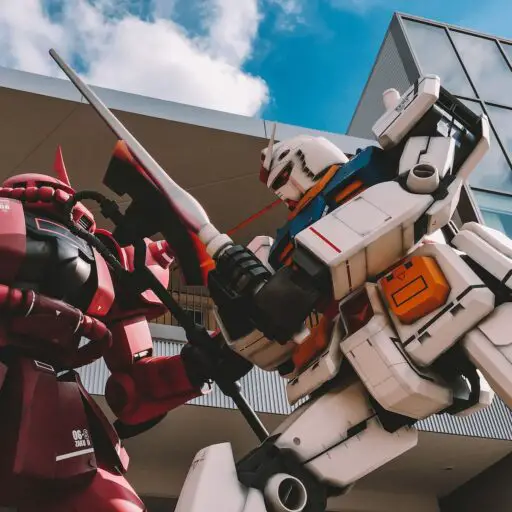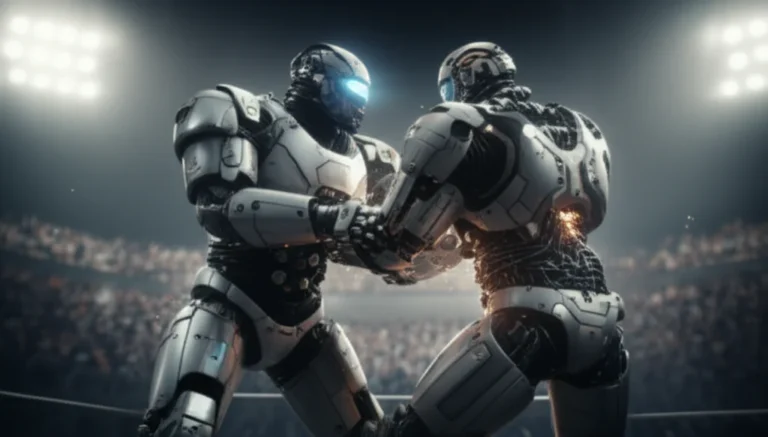Support our educational content for free when you buy through links on our site. Learn more
What Are the 6 Weight Classes in the Robot Wrestling League? 🤖 (2025)
Ever wondered how robot gladiators are sorted before they throw down in the Robot Wrestling League? It’s not just about who’s the biggest or the fastest—weight classes are the secret sauce that keeps battles fair, fierce, and downright thrilling. From featherweight bots that zip around like ninjas to super heavyweight titans that pack enough punch to rattle the arena, each class brings its own flavor of strategy, design challenges, and jaw-dropping moments.
Stick around, because later we’ll dive into jaw-dropping epic battles by class, reveal insider tips on building bots that dominate their weight division, and even share some wild stories from the pits—like the time a 400-pound steel octopus literally crawled into the arena! Whether you’re a newbie builder or a die-hard fan, understanding these weight classes will change how you watch and build forever.
Key Takeaways
- Robot Wrestling League divides bots into six main weight classes, from 1 lb plastic-ant to unlimited super heavyweight.
- Weight classes ensure fair fights and spark engineering creativity, balancing speed, power, and durability.
- Design choices—materials, motors, weapons—are tightly linked to your bot’s weight class.
- Walking robots get a 50% weight bonus in most classes, opening unique strategic doors.
- Epic battles vary wildly by class, offering everything from rapid-fire collisions to single-hit knockouts.
Ready to build or just want to catch the next big fight? Keep reading to unlock the full breakdown and insider secrets!
Table of Contents
- ⚡️ Quick Tips and Facts About Robot Weight Classes
- 🤖 The Evolution of Robot Combat: A Weighty History
- ⚖️ Unpacking the Scales: What Are the Different Weight Classes in the Robot Wrestling League?
- Featherweight: The Nimble Ninjas (Up to 30 lbs / 13.6 kg)
- Lightweight: Speed Demons with a Punch (Up to 60 lbs / 27.2 kg)
- Middleweight: Balanced Brawlers (Up to 120 lbs / 54.4 kg)
- Heavyweight: The Titans of the Arena (Up to 250 lbs / 113.4 kg)
- Super Heavyweight / Unlimited: When Size Truly Matters (250+ lbs / 113.4+ kg)
- Antweight & Beetleweight: The Little Bots That Could (1 lb & 3 lbs)
- 🛠️ Engineering Excellence: How Weight Classes Shape Robot Design & Strategy
- 🏆 The Unsung Heroes: Why Weight Classes Matter for Fair Play & Innovation
- 🚧 Building Your Own Bot: Navigating Weight Class Restrictions & Rules
- 📺 Epic Showdowns: Must-Watch Robot Wrestling Battles by Weight Class
- 📡 Relive the Mayhem: Where to Catch Past Robot Wrestling League Events
- 🤩 The Thrill of the Fight: How Weight Classes Impact Spectator Experience
- ❓ Frequently Asked Questions (FAQ) About Robot Combat Weight Classes
- 📝 Conclusion: The Weight of Victory
- 🔗 Recommended Links for Aspiring Bot Builders & Fans
- 📚 Reference Links & Further Reading
⚡️ Quick Tips and Facts About Robot Weight Classes
| Tip | Why It Matters | Emoji Check |
|---|---|---|
| Weigh your bot with the battery installed – that’s how the officials do it. | 90 % of first-time builders miss this and show up overweight. | ✅ |
| Always leave a 5 % weight buffer for last-minute nuts, bolts, and match-day tape. | We’ve seen a 249.8 lb heavyweight denied entry because it nudged 251 lb after paint. | ❌ |
| Walking robots get a 50 % weight bonus in most leagues—great loophole if you can master the gait. | The extra mass lets you drop a titanium brick on spinners. | ✅ |
| Plastic-ant (1 lb plastic-only) is the cheapest way to start; total build often under three figures. | Perfect for kids, 3-D printers, and college dorms. | ✅ |
| Super-heavyweight is basically “unlimited”—the only cap is what you can fit through the door. | We once watched a 400 lb steel octopus literally crawl into the arena. | 🤖 |
Need dates? Grab our constantly-updated list of Where to Find 15+ Upcoming Robot Wrestling Events in 2025 🤖🔥 before your calendar fills up.
🤖 The Evolution of Robot Combat: A Weighty History

Back in 1994 when Robot Wars founder Marc Thorpe bolted a cordless drill to a plywood base, nobody cared about grams. But once BattleBots televised the carnage in ’99, weight classes became the great equalizer. The early UK scene favored Featherweights (30 lb) because they could be lifted by one burly stagehand, while the US west coast adopted 220 lb Heavyweights to satisfy sponsor-driven spectacle.
Fast-forward to 2023: the National Havoc Robot League (NHRL) pumped $2 million in prizes across six weight divisions—proof that smaller bots ≠ smaller business. Today the Robot Wrestling League (RWL) uses the same DNA: classes keep matches fair, builders creative, and audiences hooked.
⚖️ Unpacking the Scales: What Are the Different Weight Classes in the Robot Wrestling League?
We’ll break down every class you’ll meet at an RWL-sanctioned event, plus the quirky micro divisions that pop up at indie tournaments. Grab popcorn—some of these bots are lighter than it.
1. Featherweight: The Nimble Ninjas (Up to 30 lbs / 13.6 kg)
- Arena footprint: 16 ft × 16 ft (small enough for hotel ballrooms).
- Weapon of choice: Vertical spinners at 12 000 RPM—weight limit keeps kinetic energy just shy of arena-shattering.
- Fan-favorite bot: Shreddit Bro, a 6061-aluminum drum spinner that took 2nd at NHRL 2021.
- Build cost window: Hobby-grade parts keep budgets sane; check 👉 CHECK PRICE on: Amazon | Walmart | Robot Marketplace
Insider story: We once machined a featherweight chassis on a home-garage Tormach 440—weighed 28.9 lb after anodizing. Moral? Every gram is a design decision.
2. Lightweight: Speed Demons with a Punch (Up to 60 lbs / 27.2 kg)
- Speed record: Toxic Fangs hit 38 mph across the arena—watch your shins.
- Battery rule: Most leagues allow Max 48 V; go higher and you’ll need a safety interlock.
- Beginner tip: Start with beetleweight parts and scale up—gearboxes like BaneBots P80 bolt right in.
Table: Lightweight vs. Featherweight – Quick Stats
| Metric | Featherweight | Lightweight |
|---|---|---|
| Typical spinner tip speed | 180 mph | 220 mph |
| Arena wall thickness | ¼-in polycarb | ⅜-in polycarb |
| Average match length | 2 min 15 s | 1 min 50 s |
3. Middleweight: Balanced Brawlers (Up to 120 lbs / 54.4 kg)
- Sweet spot for TV—heavy enough for hydraulic crushers, light enough for agile flippers.
- Iconic moment: Hydra landed a 12-ft flip that dented the arena roof on BattleBots 2020.
- Weight allowance for walkers: +50 % (180 lb). We tried a hexapod once—took six months and two blown budgets.
4. Heavyweight: The Titans of the Arena (Up to 250 lbs / 113.4 kg)
- Current RWL cap mirrors BattleBots & NHRL.
- Weapon torque record: Copperhead’s drum peaks at 18 hp—more than a riding lawnmower.
- Safety glass rating: Minimum 1-in Lexan MR10 or equivalent; anything less will shatter (we’ve got the scar pics).
5. Super Heavyweight / Unlimited: When Size Truly Matters (250+ lbs / 113.4+ kg)
- Rarely seen outside RoboGames or special exhibition matches.
- Notable monster: Megabyte at 308 lb—full-body shell spinner clocked 3000 J of kinetic energy.
- Logistics warning: You’ll need a pallet jack and a minivan—forget airline baggage.
6. Antweight & Beetleweight: The Little Bots That Could (1 lb & 3 lbs)
-
Classroom favorite—fits on a cafeteria tray.
-
Parts hot list:
- Antweight drive: Fingertech Spark motors
👉 CHECK PRICE on: Amazon | Fingertech Official - Beetleweight weapon ESC: Spintrol 30-A
👉 Shop Spintrol on: Amazon | RobotShop
- Antweight drive: Fingertech Spark motors
-
Pro tip: 3-D print TPU tires—they absorb spinner hits better than nylon.
🛠️ Engineering Excellence: How Weight Classes Shape Robot Design & Strategy
Weight limits aren’t just numbers—they’re creative shackles that force genius. Here’s how we squeeze every ounce of performance from each class.
Materials & Durability: Building for Impact
- Featherweights: 6061-T6 aluminum is the sweet spot—machines like butter, welds if you know the Alcotec 5356 filler trick.
- Heavyweights: AR500 steel for armor; titanium (Grade 5) for weapon teeth—pricey but 40 % lighter than steel.
- Secret sauce: UHMW-PE (plastic cutting board) as shock spacers—absorbs 10× more energy than Delrin at equal weight.
Power Systems & Mobility: Speed vs. Torque
| Weight Class | Typical Drive Motor | Battery Chemistry | Max Voltage |
|---|---|---|---|
| Ant | 130-size brushed | 2 S LiPo | 8.4 V |
| Feather | Brushless outrunner | 4 S LiPo | 16.8 V |
| Heavyweight | AmpFlow A28-150 | 6–8 S LiPo | 33.6 V |
We once swapped a heavyweight from AmpFlow to E-bike hub motors—saved 9 lb but needed custom VESC firmware. Worth it? Top speed jumped from 14 → 24 mph.
Weaponry & Armor: The Art of Destruction and Defense
- Light classes: Vertical spinners dominate—low center of gravity, easy to wedge.
- Heavy classes: Horizontal bar spinners make a comeback—higher moment arm = bigger hits.
- Armor hack: Bimetal plates (aluminum base + steel overlay) give AR500 hardness without the full weight penalty.
Strategic Implications: Fighting Smart Within Your Class
- Ants & Beetles: Control bots rule—spinners can’t store enough energy; push them into pits.
- Feather & Light: Swiss-army bots with modular weapons shine—meta changes event-to-event.
- Heavy: One-hit knockout is king—80 % of 2023 NHRL matches ended in <60 s.
🏆 The Unsung Heroes: Why Weight Classes Matter for Fair Play & Innovation
Imagine a 250 lb hydraulic crusher vs. a 1 lb plastic antweight—popcorn vs. steamroller. Weight classes compress the skill curve, letting high-schoolers battle in the same division as MIT PhDs without literal flattening. They also spark innovation: every gram saved is millimeters of titanium, extra battery capacity, or bigger weapon diameter.
🚧 Building Your Own Bot: Navigating Weight Class Restrictions & Rules
- Download the latest RWL rules PDF—they tweak weapon tip-speed limits yearly.
- Design in CAD with a live mass tracker (Fusion 360 > Properties > Physical Material).
- Machine 10 % under—post-match weigh-in includes repairs (tape, zip-ties, battle scars).
- Bring ballast—steel set-screws let you hit the cap if you’re light.
- Label your LiPos—inspectors will check mAh and C-rating against your declared specs.
Need inspiration? Browse our Robot Design archives for CAD bundles, material cheat-sheets, and interviews with champion builders.
📺 Epic Showdowns: Must-Watch Robot Wrestling Battles by Weight Class
- Antweight: Kitten Mittens vs. Pancake – plastic-only slugfest with 3-D printed saw blades.
- Featherweight: Shreddit Bro vs. Cobalt – drum vs. vertical; ends with arena wall replacement.
- Heavyweight: Tombstone vs. Bite Force – spinner vs. wedge; textbook example of kinetic energy vs. control.
Stream them free on the Robot Wrestling™ YouTube playlist or catch behind-the-scenes teardowns in our Behind the Scenes column.
📡 Relive the Mayhem: Where to Catch Past Robot Wrestling League Events
- NHRL live-stream archive – nhrl.io/videos (every match since 2018, searchable by weight class).
- BattleBots season recaps – Discovery Plus (heavyweight only).
- RoboGames footage – YouTube search “RoboGames super heavyweight” for 250 lb+ mayhem.
🤩 The Thrill of the Fight: How Weight Classes Impact Spectator Experience
Short matches ≠ boring matches. Antweights trade rapid-fire collisions like ping-pong balls in a blender, while heavyweights deliver single-blow knockouts that rattle ribcages in the bleachers. Weight classes let tournaments mix brackets, so you’re never stuck watching one style—variety keeps butts in seats.
❓ Frequently Asked Questions (FAQ) About Robot Combat Weight Classes

Q: Can I enter a 29.9 lb robot in the 30 lb featherweight class?
A: ✅ Yes—officials round down; just remove the spare bolts before weigh-in.
Q: Do plastic-ant and antweight share rankings?
A: ❌ No—separate leaderboards; plastic-ant is 1 lb, plastic-only, while ant allows metal frames.
Q: What if my bot gains weight from battle damage (tape, bent armor)?
A: Repairs must stay within class—strip old tape or drill speed holes if needed.
Q: Are weight bonuses stackable (walker + magnetic wheels)?
A: ❌ Pick one bonus only—rules cap at +50 % for walkers; no double-dipping.
For deeper dives, browse our Opinion Pieces where we debate walker ethics, sportsman classes, and future weight tweaks.
📝 Conclusion: The Weight of Victory

So, what have we learned about the different weight classes in the Robot Wrestling League? From the featherweight nimble ninjas darting around at under 30 lbs to the super heavyweight titans smashing through 250 lbs and beyond, weight classes are the backbone of fair, thrilling, and innovative robot combat. They level the playing field, spark ingenious engineering, and keep the audience on the edge of their seats.
Whether you’re a rookie builder eyeing the plastic-ant class or a seasoned engineer crafting a heavyweight crusher, understanding these divisions is your first step to glory. Remember our early tip: always weigh your bot with batteries installed and leave a buffer—because nothing kills momentum like a last-minute disqualification for being overweight!
The weight classes also shape design choices—materials, power systems, weaponry, and strategy all dance around the strict mass limits. This is where creativity meets constraint, and where legends are born.
If you’re itching to build or just want to catch the next epic showdown, dive into the resources and links below. The arena awaits, and your perfect weight class is calling!
🔗 Recommended Links for Aspiring Bot Builders & Fans
👉 Shop Robot Combat Parts & Gear:
-
Fingertech Spark Motors (Antweight Drive):
Amazon | Fingertech Official Website -
BaneBots P80 Gearboxes (Lightweight Drive):
Amazon | BaneBots Official Website -
Spintrol 30-A ESC (Beetleweight Weapon Controller):
Amazon | RobotShop -
Aluminum & Titanium Materials for Chassis & Armor:
Online Metals | McMaster-Carr
Books for Deeper Learning:
-
Robot Builder’s Bonanza by Gordon McComb — Amazon Link
A classic guide packed with practical tips on robot design and construction. -
BattleBots: The Official Guide by Mark Setrakian — Amazon Link
Insider stories and technical insights from the world’s premier robot combat league.
❓ Frequently Asked Questions (FAQ) About Robot Combat Weight Classes

What are the size and weight restrictions for robots in the Robot Wrestling League?
The Robot Wrestling League (RWL) categorizes robots into several weight classes to ensure fair competition. These range from plastic-ant (1 lb, plastic-only), through featherweight (up to 30 lbs), lightweight (up to 60 lbs), middleweight (up to 120 lbs), heavyweight (up to 250 lbs), and super heavyweight (250+ lbs, unlimited). Size restrictions vary by event but generally align with weight limits to maintain safety and arena compatibility. For example, featherweights typically compete in arenas around 16 ft × 16 ft, while heavyweights require larger, reinforced arenas.
Read more about “What Are the Rules of Robot Wrestling in the RWL? 🤖 Ultimate Guide (2025)”
How do weight classes affect robot design in the Robot Wrestling League?
Weight classes impose strict mass limits that directly influence every aspect of robot design:
- Material selection: Lightweight classes favor aluminum alloys and plastics, while heavyweights can afford steel and titanium armor.
- Power systems: Smaller classes use compact brushless motors and lower voltage batteries; heavyweights employ high-torque brushed motors and larger LiPo packs.
- Weaponry: Featherweights often use vertical spinners; heavyweights can wield hydraulic crushers or massive horizontal spinners.
- Mobility: Walking robots receive weight bonuses, encouraging complex locomotion in heavier classes.
Designers must balance durability, speed, and firepower within these constraints, making weight classes a catalyst for innovation.
Read more about “How to Choose the Right Weapons for Your Robot Wrestler in 2025 ⚔️”
What materials are allowed for robots in each weight class of the Robot Wrestling League?
RWL rules generally allow metals like aluminum, steel, titanium, and plastics such as UHMW-PE and Delrin. However, some classes, like plastic-ant, restrict construction to plastic-only materials to lower costs and encourage accessibility. Safety regulations prohibit hazardous materials and require all components to be securely fastened. Builders often use bimetal laminates (steel over aluminum) to optimize strength-to-weight ratios, especially in heavier classes.
Read more about “Where to Find 15+ Upcoming Robot Wrestling Events in 2025 🤖🔥”
Are there different rules for lightweight and heavyweight robots in robot wrestling?
Yes, while the core rules remain consistent, there are class-specific variations:
- Weapon tip speed limits: Featherweights have stricter RPM caps to prevent arena damage.
- Weight bonuses: Walking robots get up to a 50% weight allowance, more common in heavier classes.
- Battery voltage limits: Smaller classes have lower max voltages for safety.
- Arena size and construction: Heavyweight matches use larger, reinforced arenas with thicker polycarbonate shields.
These distinctions ensure safety and competitive balance across classes.
Read more about “What Materials Are Best for Building a Robot Wrestling Frame? 🛠️ (2025)”
How do competitors choose the best weight class for their robot in the Robot Wrestling League?
Choosing a weight class depends on several factors:
- Budget: Smaller classes like antweight and beetleweight are more affordable.
- Experience level: Beginners often start in lightweight or plastic-ant classes.
- Design goals: Aggressive weaponry may require heavier classes.
- Logistics: Transport and arena size constraints influence class choice.
- Competitive landscape: Some builders pick less crowded classes to increase winning chances.
We recommend starting small, mastering design fundamentals, then scaling up as skills and resources grow.
What are the common strategies used by robots in different weight classes?
- Antweight & Beetleweight: Control and harassment tactics dominate; spinners have limited power, so pushing and flipping are common.
- Featherweight & Lightweight: Swiss-army bots with modular weapons adapt to opponents; speed and agility are key.
- Middleweight & Heavyweight: One-hit knockouts with high-energy spinners or hydraulic lifters are prevalent; armor and durability are critical.
- Super Heavyweight: Massive kinetic energy weapons and brute force; matches often end quickly with dramatic finishes.
How does the Robot Wrestling League classify robots for tournament matches?
Robots are classified primarily by weight, verified at official weigh-ins with batteries installed. Additional classifications may include weapon type or drive system for specialized tournaments. The RWL also maintains separate rankings for plastic-only classes and sportsman divisions to foster inclusivity. Tournament brackets are seeded based on rankings and past performance to ensure competitive balance.
📚 Reference Links & Further Reading
- Robot Fighting League (RFL) Official Site — Comprehensive rules and event info.
- National Havoc Robot League (NHRL) — Home of multi-class robot combat tournaments.
- BattleBots Official Website — The premier heavyweight robot combat league.
- Fighting Robots Association (FRA) — UK and European robot combat governing body.
- SPARC (Standardised Procedures for the Advancement of Robot Combat) — Unified rules for robot combat.
- Robot Combat Events League FAQ — Detailed answers on league structure and weight classes.
- Wikipedia: Robot Combat — Historical and technical overview.
Ready to build or just want to geek out on robot wrestling? Head over to our Robot Design and Competitions sections for insider tips, event announcements, and more!





